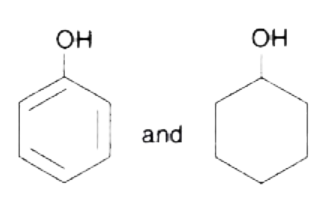Give the chemical tests distinguish between the following pairs:
Copper sulphate and Iron (II) sulphate.
To distinguish between copper sulfate (CuSO4) and iron (II) sulfate (FeSO4), we can perform a chemical test using ammonium hydroxide (NH4OH). Here are the steps involved in the process:
1. Prepare the Solutions:
- Take a small amount of copper sulfate solution (CuSO4) in a test tube.
- In another test tube, take a small amount of iron (II) sulfate solution (FeSO4).
2. Add Ammonium Hydroxide:
- To the test tube containing copper sulfate, add a few drops of ammonium hydroxide (NH4OH).
- In a separate test tube, add a few drops of ammonium hydroxide to the iron (II) sulfate solution.
3. Observe the Reactions:
- For the copper sulfate solution:
- A pale blue precipitate of copper hydroxide (Cu(OH)2) will form.
- The reaction can be represented as:
CuSO4+2NH4OH→Cu(OH)2↓+(NH4)2SO4
- For the iron (II) sulfate solution:
- A pale green precipitate of ferrous hydroxide (Fe(OH)2) will form.
- The reaction can be represented as:
FeSO4+2NH4OH→Fe(OH)2↓+(NH4)2SO4
4. Compare the Precipitates:
- The precipitate formed from copper sulfate will be pale blue.
- The precipitate formed from iron (II) sulfate will be pale green.
5. Conclusion:
- By observing the color of the precipitates, we can distinguish between copper sulfate and iron (II) sulfate. The pale blue precipitate indicates the presence of copper sulfate, while the pale green precipitate indicates the presence of iron (II) sulfate.
- Take a small amount of copper sulfate solution (CuSO4) in a test tube.
- In another test tube, take a small amount of iron (II) sulfate solution (FeSO4).
- To the test tube containing copper sulfate, add a few drops of ammonium hydroxide (NH4OH).
- In a separate test tube, add a few drops of ammonium hydroxide to the iron (II) sulfate solution.
- For the copper sulfate solution:
- A pale blue precipitate of copper hydroxide (Cu(OH)2) will form.
- The reaction can be represented as:
CuSO4+2NH4OH→Cu(OH)2↓+(NH4)2SO4
- For the iron (II) sulfate solution:
- A pale green precipitate of ferrous hydroxide (Fe(OH)2) will form.
- The reaction can be represented as:
FeSO4+2NH4OH→Fe(OH)2↓+(NH4)2SO4
- The precipitate formed from copper sulfate will be pale blue.
- The precipitate formed from iron (II) sulfate will be pale green.
- By observing the color of the precipitates, we can distinguish between copper sulfate and iron (II) sulfate. The pale blue precipitate indicates the presence of copper sulfate, while the pale green precipitate indicates the presence of iron (II) sulfate.
Topper's Solved these Questions
- SAMPLE QUESTION PAPER 5BOOK - ICSECHAPTER - SAMPLE QUESTION PAPER 5EXERCISE - Section I(Choose the correct answer)
5 Videos
- SAMPLE QUESTION PAPER 5BOOK - ICSECHAPTER - SAMPLE QUESTION PAPER 5EXERCISE - Section II
35 Videos
- SAMPLE QUESTION PAPER 03BOOK - ICSECHAPTER - SAMPLE QUESTION PAPER 03EXERCISE - SECTION II
47 Videos
- SELF ASSESSMENT PAPER 05BOOK - ICSECHAPTER - SELF ASSESSMENT PAPER 05EXERCISE - SECTION II (Fill in the blanks with the choice given in the brackets. )
5 Videos
Similar Questions
Give chemical test to distinguish between

View SolutionGive a chemical test to distinguish between the following pairs of compounds:

View SolutionGive the chemical tests between the following pairs:
Iron (II) sulphate and Iron (III) sulphate.
View SolutionGive a chemical test to distinguish between the following:
Sodium sulphate and ammonium sulphate.
View SolutionGive a chemical test to distinguish between the following gases
NH3 and HCI
View SolutionGive a chemical test to distinguish between the following gases
HCI and CI2
View SolutionGive one chemical test to distinguish between the following pairs of compounds.
Iron (II) chloride solution and Iron (III) chloride solution.
View SolutionGive a chemical test to distinguish between each of the following pairs :
Methane & ethyne
View SolutionGive a chemical test to distinguish between each of the following pairs :
Ethane & ethanol
View SolutionGive a chemical test to distinguish between the following:
Ferric salt and ferrous salt.
View Solution
